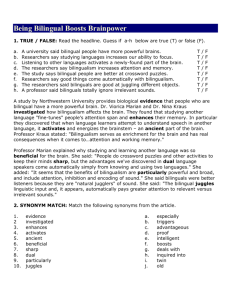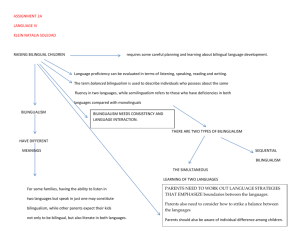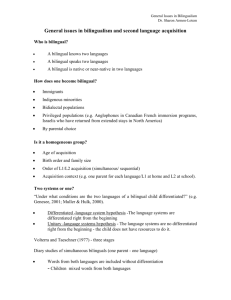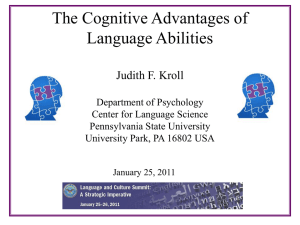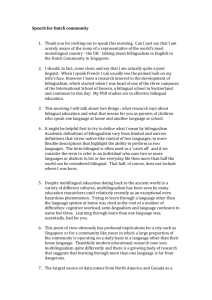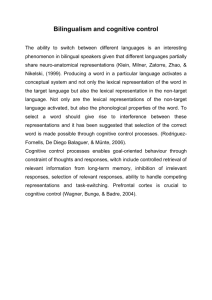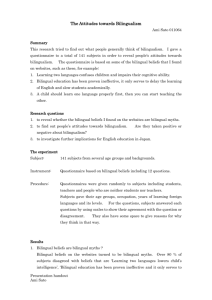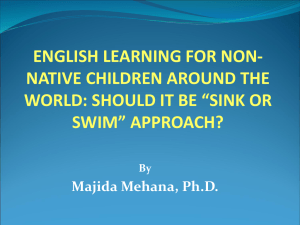Leader`s guide - Training to Enhance Services for English Language
advertisement
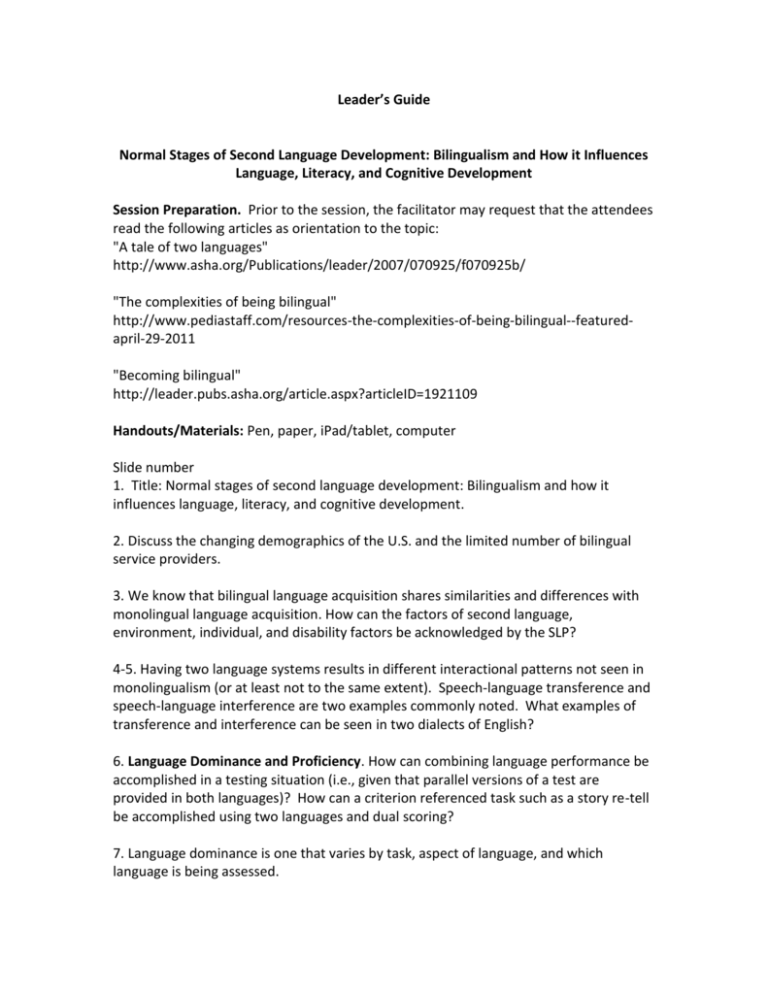
Leader’s Guide Normal Stages of Second Language Development: Bilingualism and How it Influences Language, Literacy, and Cognitive Development Session Preparation. Prior to the session, the facilitator may request that the attendees read the following articles as orientation to the topic: "A tale of two languages" http://www.asha.org/Publications/leader/2007/070925/f070925b/ "The complexities of being bilingual" http://www.pediastaff.com/resources-the-complexities-of-being-bilingual--featuredapril-29-2011 "Becoming bilingual" http://leader.pubs.asha.org/article.aspx?articleID=1921109 Handouts/Materials: Pen, paper, iPad/tablet, computer Slide number 1. Title: Normal stages of second language development: Bilingualism and how it influences language, literacy, and cognitive development. 2. Discuss the changing demographics of the U.S. and the limited number of bilingual service providers. 3. We know that bilingual language acquisition shares similarities and differences with monolingual language acquisition. How can the factors of second language, environment, individual, and disability factors be acknowledged by the SLP? 4-5. Having two language systems results in different interactional patterns not seen in monolingualism (or at least not to the same extent). Speech-language transference and speech-language interference are two examples commonly noted. What examples of transference and interference can be seen in two dialects of English? 6. Language Dominance and Proficiency. How can combining language performance be accomplished in a testing situation (i.e., given that parallel versions of a test are provided in both languages)? How can a criterion referenced task such as a story re-tell be accomplished using two languages and dual scoring? 7. Language dominance is one that varies by task, aspect of language, and which language is being assessed. 8. Language Maintenance. Discuss the various reasons that the native language be spoken in the home and/or why English in the home can lead to decreased English abilities (for example, possibly a poor English model, decreased parent abilities to communicate with their children, limited language modeling, etc.). 9. Discuss what it means to have a strong language base. Research by Thomas and Collier (1997) has shown that when children do not have a strong base in their first language, then it typically takes longer to acquire English when compared to children with a good first language base. 10. Language Deceleration. What are some the demands upon learning two languages? Investigate the term "ultimate attainment" with second language learners. 11. Code Switching and Code Mixing. Have your heard the term "Spanglish"? Code switching and code mixing are natural phenomena and are not indicators of a language learning disability. Typically developing bilinguals and fully developed bilinguals code switch and code mix. What are the advantages of code switching/mixing and how can it be incorporated into therapy? 12. Code switching and code mixing display developmental rules. It is easier to change than mix languages. Can you code switch from one dialect to another? Give some examples. 13. How can code mixing be used to enhance English skills? One example is that students may intersperse their limited English words into their native language while working on academics. An example may be, "La respuesta es six (the answer is six)." 14. Language deficiencies can be seen in code switching and code mixing. Please note that this is not saying that CS and CM are deficient, but rather that deficiencies can be seen in CS and CM. 15-16. Ultimate Attainment. This is the ability to reach native or native-like abilities in the 2nd language. Also, note that ultimate attainment may occur at the loss of the native language. Hence, it is beneficial to be able to keep both languages (a term referred to as language maintenance or additive bilingualism). 17-18. Language Loss or Attrition. What are some the detrimental effects of language loss on the native or home language? What can SLPs do to facilitate language maintenance and not language loss? 19. Language Fossilization. Language growth stops due to personal and environmental factors. Have the audience develop suggestions and strategies for overcoming fossilization. Focus on instruction and communication skills. 20. Environmental Factors. You are a school based SLP and the school principal wishes to mainstream an English learner after one year of ESL/ESOL instruction. What suggestions can you give the principal citing the 4 factors discussed by Wong-Fillmore? 21. Individual and Developmental Factors. It is well documented that gifted and talented students will accelerate through language acquisition of their second language. It is also likely that students with disabilities may need more time, but still be able to acquire both of their languages given their disability (Kohnert, 2013). 22-23. Disability Factors. What examples can you give regarding the four stages of development for monolingual and bilingual children with and without disabilities? Discuss why learning another language is an added issue? 24-25. Strategies for Promoting Bilingualism. How can SLPs promote bilingualism in speech and language therapy, especially when the SLP is monolingual? Some discussion suggestions may include: (a) pair two bilingual students together, especially if one student demonstrates stronger English skills; (b) allow for bilingual exchanges to occur; (c) provide materials in the native language and English; (d) encourage parents and family members to speak the native language in the home; (e) send books in the native language home (if the parents are illiterate, try to find someone who can record the book in the native language and send this tape, audio clip home); (f) find native language sites on the web that include therapeutic/educational materials.


